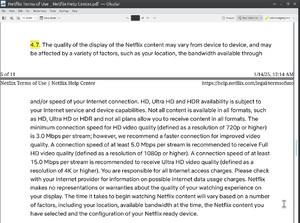Please note that all submissions to the site are subject to the wiki's licence, CC 4.0 BY-SA, as found here
Netflix 4K Stream Quality Controversy
4K plan doesn't provide a 4k resolution stream[edit | edit source]
Netflix imposes restrictions on accessing 4K streaming and does not fully disclose the conditions under which these restrictions apply; all prerequisites for receiving a 4K stream are not listed in the terms of use[1], terms & conditions[2], or help page[3]. When new users sign up, Netflix defaults them to the 4K premium plan, without clearly informing them of the intentional limitations on accessing 4K content[4]. If users were aware of these limitations, they might choose not to subscribe to the more expensive plan that Netflix defaults to; however, this information is not provided upfront. This lack of transparency is problematic for customers that may expect 4K content and not understand why they are not receiving it.
Netflix, in their Terms of Service (TOS), lists reasons why the quality of its content may vary from different devices, as stated in clause 4.7: "The quality of the display of the Netflix content may vary from device to device, and may be affected by a variety of factors, such as your location, the bandwidth available through and/or speed of your Internet connection." One of the factors not listed is the use of Widevine, a Digital Rights Management (DRM) software which is embedded into most web browsers such as Chrome, Chromium, Electron (CEF), Firefox, Edge, Opera, Safari, etc. A DRM protects media hosted on Netflix from being screen-captured, with one of the methods using "SECURE_DECODE", which uses Widevine to decode each frame displayed. This method demands more bandwidth, with Netflix appeasing the disparity by decreasing the quality to 720p on web browsers.
Currently, Netflix offers 1080p video resolution on every plan they offer on their Plans and Pricing for a subscription. Consumers who watch Netflix on web browsers will be paying for 1080p resolution while only receiving 720p resolution maximum due to DRM. The TOS allows Netflix to claim the user's device faulty or the user's internet speed slow to justify this behaviour.


The only time the user is shown the existence of such limitations is in a small font, on the bottom of the page where the user chooses a plan. The 4k HDR option is the default option and has an icon with very appealing colors that draw the user's eyes to this more expensive option, whilst the user must scroll to the bottom to be linked to a document that explains the limitations.[1] The explanation provided on this terms of service that must be dug through, is completely inadequate. See below:
4K content isn't available on the platform even when it exists[edit | edit source]
Netflix routinely licenses HD content even though 4K HDR is readily available, including for blockbuster movies[citation needed ]. This isn't advertised anywhere[citation needed ].
For example: Transformers: Rise of the Beasts is HD only on Netflix[5], whereas it’s clearly available in UHD on other platforms[6], or Blu-ray[7].
Terms of Service analysis[edit | edit source]
Currently, Netflix offers 1080p video resolution on every plan they offer on their Plans and Pricing for a subscription. Consumers who watch Netflix on web browsers will be paying for 1080p resolution while only receiving 720p resolution maximum, because of DRM. The TOS allows Netflix to claim the user's device faulty or the user's internet speed slow to justify this behavior with the line "The quality of the display of the Netflix content may vary from device to device, and may be affected by a variety of factors, such as your location, the bandwidth available through and/or speed of your Internet connection. HD, Ultra HD and HDR availability is subject to your Internet service and device capabilities.", even when a user's internet connection is more than sufficient for a 4K full bitrate stream. [8][1]
Netflix's Terms of Service (TOS) describes important information about video-quality limitations in Section 4.7, which states:
4.7. The quality of the display of the Netflix content may vary from device to device, and may be affected by a variety of factors, such as your location, the bandwidth available through and/or speed of your Internet connection. HD, Ultra HD and HDR availability is subject to your Internet service and device capabilities. Not all content is available in all formats, such as HD, Ultra HD or HDR and not all plans allow you to receive content in all formats. The minimum connection speed for HD video quality (defined as a resolution of 720p or higher) is 3.0 Mbps per stream; however, we recommend a faster connection for improved video quality. A connection speed of at least 5.0 Mbps per stream is recommended to receive Full HD video quality (defined as a resolution of 1080p or higher). A connection speed of at least 15.0 Mbps per stream is recommended to receive Ultra HD video quality (defined as a resolution of 4K or higher). You are responsible for all Internet access charges. Please check with your Internet provider for information on possible Internet data usage charges. Netflix makes no representations or warranties about the quality of your watching experience on your display. The time it takes to begin watching Netflix content will vary based on a number of factors, including your location, available bandwidth at the time, the Netflix content you have selected and the configuration of your Netflix ready device.
Streaming requirements and lack of disclosure[edit | edit source]
Complete list of requirements[edit | edit source]
- Netflix Premium plan: Subscription to the Premium Plan.
- Device compatibility: Devices must support 4K playback and be Netflix-certified.
- Processor: An Intel 7th generation Core CPU or newer with Intel SGX enabled, or an AMD Ryzen CPU.[9][10]
- GPU: Nvidia GeForce GPU 1050 or newer, AMD Radeon RX 400 series or newer GPU.[9]
- Display requirements: A screen with a resolution of at least 3840x2160 and HDCP 2.2-compliant HDMI ports (for external displays).
- DRM support: Hardware-based DRM like Widevine L1, PlayReady 3.0, or FairPlay is required.
- HEVC codec support: Devices must support hardware decoding of the HEVC (H.265) codec for 4K playback.
- Internet speed: A stable internet connection of at least 15 Mbps.
- Operating system: Supported OS versions, e.g., Windows 10/11, macOS (Safari), and specific Android/iOS versions.
- Browser and app compatibility: Certain browsers (e.g., Microsoft Edge, Safari) and official Netflix apps are required.
- Updated firmware and software: Devices must run the latest firmware or software, NVIDIA Driver version 387.96 or newer.[11]
- Title availability: Not all titles are available in 4K; the content must be marked as 4K or UHD.
Requirements that Netflix does disclose[edit | edit source]
- Subscription plan: The need for the Premium Plan for 4K content.
- Internet speed: The recommendation of 15 Mbps for 4K streaming.
- Device compatibility: Ensuring all devices in the setup support 4K video playback.
- Browser and app compatibility: Mention that Microsoft Edge (version 118 or later) or the official Netflix app is required to stream 4K content on Windows-based platforms. Likewise, mention that Safari (version 12 or later) is required for 4K playback on Macs (there’s no Netflix app for macOS).[12]
- Display requirements: Mention of HDCP 2.2-compliant HDMI ports and display resolution for external devices.
- Account settings: Instructions to set playback settings to High or Auto for 4K.
- Title verification: Guidelines on identifying titles that support 4K or HDR.
- Mobile-device limitations: It mentions HDR might not stream on mobile devices in low power mode. It also addresses limitations like Widevine DRM levels.[13]
Requirements that Netflix does not disclose[edit | edit source]
- DRM requirements: No explicit mention of the need for Widevine L1, PlayReady 3.0, or FairPlay DRM.
- Codec support: The necessity of HEVC (H.265) support is not detailed.
- Processor and GPU capabilities: The requirement for devices with processors and GPUs capable of hardware decoding HEVC efficiently is not mentioned.
- Firmware updates: While it suggests keeping devices updated, there is no detail on the necessity for specific firmware versions for 4K, only for Nvidia drivers.
References[edit | edit source]
- ↑ 1.0 1.1 1.2 "Netflix Terms of Use" - help.netflix.com - 24 Jan 2024 - Archive.org Version
- ↑ "Netflix Shop - Terms & Conditions" - netflix.shop - 1 June 2023 - Archive.org Version
- ↑ "How to get the best video quality" - help.netflix.com
- ↑ File:Netflix signup page- choose plan bottom of page.png
- ↑ "Netflix - Transformers: Rise of the Beasts" - netflix.com
- ↑ "Amazon Prime - Transformers: Rise of the Beasts" - amazon.com
- ↑ "Amazon - Transformers: Rise of the Beasts [4K UHD]" - amazon.com
- ↑ File:Netflix terms of service covering streaming quality.png
- ↑ 9.0 9.1 "How to use Netflix on your Windows computer or tablet" - help.netflix.com
- ↑ "Reddit - Netflix requirements to watch 4k that you paid for" - reddit.com/r/Piracy - 3 Dec 2023
- ↑ "4K UHD Netflix content on NVIDIA GPUs" - nvidia.custhelp.com - 29 Sep 2021
- ↑ "Netflix supported browsers and system requirements" - help.netflix.com
- ↑ "How to use Netflix on your Android phone or tablet" - help.netflix.com